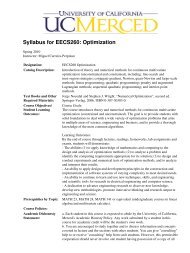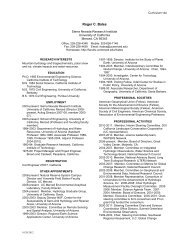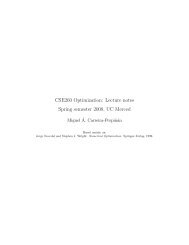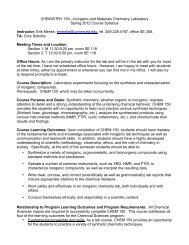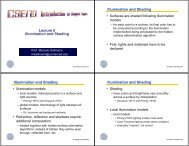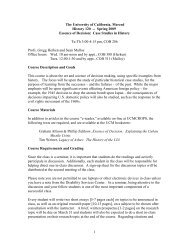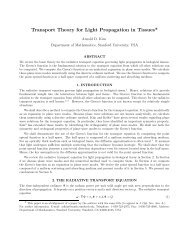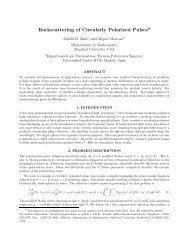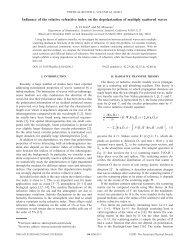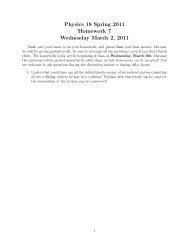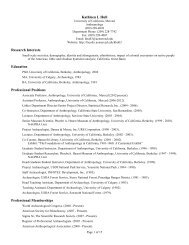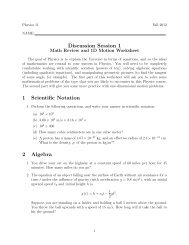Physics 18 Spring 2011 Homework 13 Wednesday April 20, 2011
Physics 18 Spring 2011 Homework 13 Wednesday April 20, 2011
Physics 18 Spring 2011 Homework 13 Wednesday April 20, 2011
You also want an ePaper? Increase the reach of your titles
YUMPU automatically turns print PDFs into web optimized ePapers that Google loves.
<strong>Physics</strong> <strong>18</strong> <strong>Spring</strong> <strong><strong>20</strong>11</strong><br />
<strong>Homework</strong> <strong>13</strong><br />
<strong>Wednesday</strong> <strong>April</strong> <strong>20</strong>, <strong><strong>20</strong>11</strong><br />
Make sure your name is on your homework, and please box your final answer. Because<br />
we will be giving partial credit, be sure to attempt all the problems, even if you don’t finish<br />
them. The homework is due at the beginning of class on <strong>Wednesday</strong>, <strong>April</strong> 27th. Because<br />
the solutions will be posted immediately after class, no late homeworks can be accepted! You<br />
are welcome to ask questions during the discussion session or during office hours.<br />
1. A string fixed at both ends resonates at a fundamental frequency of <strong>18</strong>0 Hz. Which of<br />
the following will reduce the fundamental frequency to 90 Hz?<br />
(a) Double the tension and double the length.<br />
(b) Halve the tension and keep the length and the mass per unit length fixed.<br />
(c) Keep the tension and the mass per unit length fixed and double the length.<br />
(d) Keep the tension and the mass per unit length fixed and halve the length.<br />
1
2. Estimate the resonant frequencies that are in the audible range of human hearing of<br />
the human ear canal. Treat the canal as an air column open at one end, stopped at<br />
the other end, and with a length of 1.00 in. How many resonant frequencies lie in<br />
this range? Human hearing has been found experimentally to be the most sensitive<br />
at frequencies of about 3, 9, and 15 kHz. How do these frequencies compare to your<br />
calculations?<br />
2
3. It is thought that the brain determines the direction of the source of a sound by sensing<br />
the phase difference between the sound waves striking the eardrums. A distance source<br />
emits sound of frequency 680 Hz. When you are directly facing a sound source there<br />
is no phase difference. Estimate the phase difference between the sounds received by<br />
your ears when you are facing 90 ◦ away from the direction of the source.<br />
3
4. A standing wave on a rope is represented by the wave function<br />
<br />
1<br />
y(x, t) = (0.0<strong>20</strong>) sin<br />
2 πx<br />
<br />
cos(40πt),<br />
where x and y are in meters, and t is in seconds.<br />
(a) Write wave functions for two traveling waves that, when superimposed, produce<br />
this standing-wave pattern.<br />
(b) What is the distance between the nodes of the standing wave?<br />
(c) What is the maximum speed of the rope at x = 1.0 m?<br />
(d) What is the maximum acceleration of the rope at x = 1.0 m?<br />
4
5. Ultrasound has many medical applications, one of which is to monitor fetal heartbeats<br />
by reflecting ultrasound off a fetus in the womb.<br />
(a) Consider an object moving at speed v0 toward an at-rest source that is emitting<br />
sound waves of frequency f0. Show that the reflected wave (i.e., the echo) that<br />
returns to the source has a Doppler-shifted frequency<br />
<br />
v + v0<br />
fecho = f0,<br />
v − v0<br />
where v is the speed of sound in the medium.<br />
(b) Suppose that the object’s speed is much less than the wave speed: v0 ≪ v. then<br />
fecho ≈ f0, and a microphone that is sensitive to these frequencies will detect<br />
a beat frequency if it listens to f0 and fecho simultaneously. Use the binomial<br />
expansion and other appropriate approximations to show that the beat frequency<br />
is fbeat ≈ 2v0<br />
v f0.<br />
(c) The reflection of 2.40 MHz ultrasound waves from the surface of a fetus’s beating<br />
heart is combined with the 2.40 MHz wave to produce a beat frequency that<br />
reaches a maximum of 65 Hz. What is the maximum speed of the surface of the<br />
heart? The speed of ultrasound waves within the body is 1540 m/s.<br />
(d) Suppose the surface of the heart moves in simple harmonic motion at 90 beats/min.<br />
What is the amplitude in mm of the heartbeat?<br />
5




